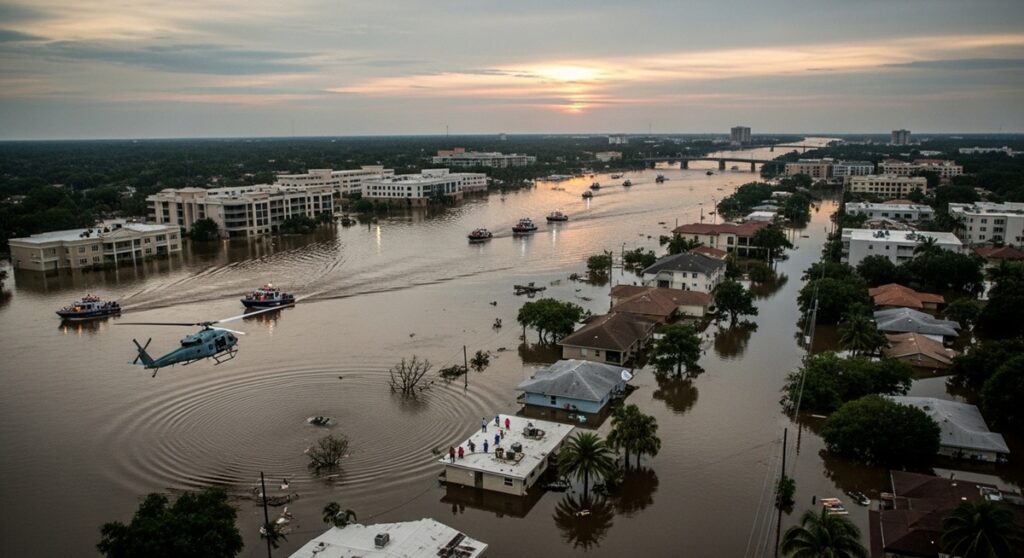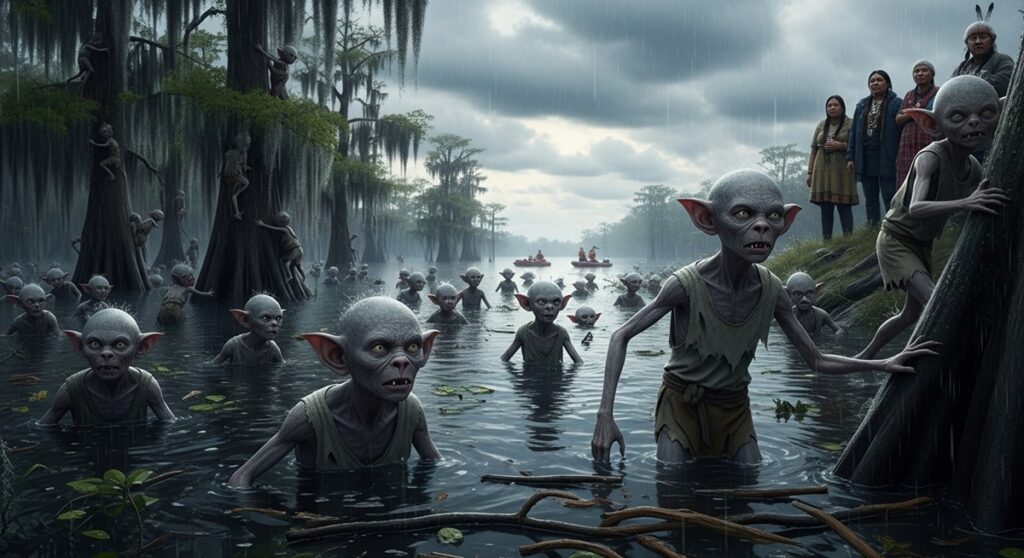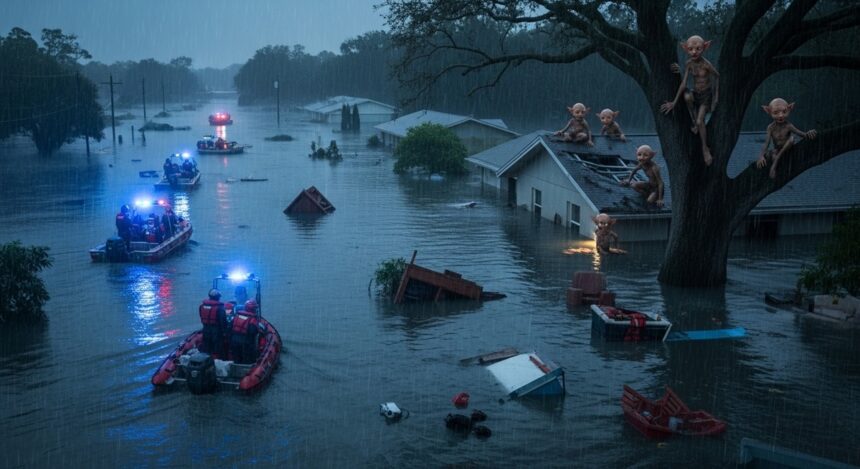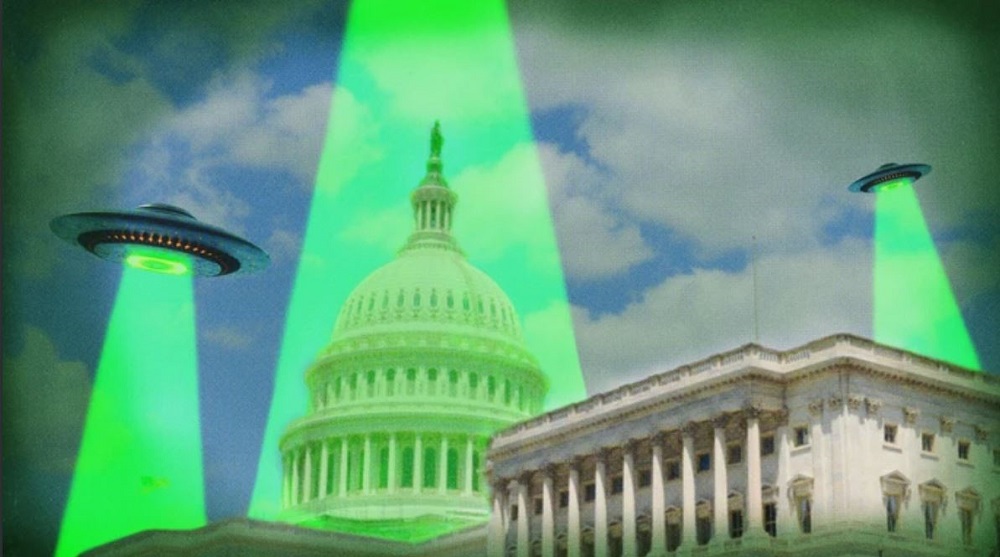In a world where natural disasters strike without warning, the United States stands as a prime example of resilience amid chaos. From raging forest fires in the West to devastating hurricanes along the coasts, and tornadoes tearing through the Midwest, these events remind us of nature’s unyielding power. No matter how advanced a society becomes, with cutting-edge technology and emergency response systems, natural disasters remain an inescapable part of life. They test communities, reshape landscapes, and sometimes, uncover secrets long buried in folklore.
One such event unfolded in 2016, when relentless heavy rains triggered widespread flooding across Florida. This catastrophe affected more than 500 settlements, displacing thousands and mobilizing a massive rescue effort. But beyond the headlines of evacuations and recovery, whispers emerged from Native American communities about strange, underground creatures forced to the surface by the rising waters. These beings, known as khari or “pointy-eared” dwellers, blended myth with reality in a way that captivated rescuers and locals alike.
The Unrelenting Fury of Nature: Understanding Natural Disasters in the US
Natural disasters have always been woven into the fabric of American history. The country’s vast geography exposes it to a spectrum of threats: seismic activity along fault lines, volcanic eruptions in the Pacific Northwest, and extreme weather patterns fueled by climate change. In recent decades, events like Hurricane Katrina in 2005 and Superstorm Sandy in 2012 have highlighted vulnerabilities in infrastructure and emergency preparedness.
Floods, in particular, rank among the most common and destructive natural disasters. They can stem from prolonged rainfall, storm surges, or even dam failures, leading to billions in damages annually. According to federal reports, the US experiences an average of $10 billion in flood-related losses each year, with coastal states like Florida bearing a disproportionate share due to their low-lying terrain and subtropical climate.
What makes these events so challenging is their unpredictability. Forest fires might be contained with firebreaks and aerial drops, but floods seep insidiously, turning streets into rivers and homes into islands. Hurricanes and tornadoes add layers of wind damage, compounding the chaos. Governments at all levels—federal, state, and local—invest heavily in mitigation, from levee systems to early warning alerts. Yet, as the 2016 Florida flood demonstrated, even the best plans can be overwhelmed by nature’s scale.
The 2016 Florida Flood: A State Submerged
In the summer of 2016, Florida faced one of its most severe flooding episodes in recent memory. Triggered by a series of tropical disturbances and unseasonably heavy rains, rivers overflowed, and lowlands turned into vast lakes. Over 500 communities, from bustling urban centers to rural hamlets, found themselves in the disaster zone. Rainfall totals exceeded 20 inches in some areas, leading to flash floods that caught residents off guard.
Evacuations were swift and massive. Authorities deployed hundreds of boats, helicopters, and heavy machinery to rescue stranded individuals. Tens of thousands of workers, including professional rescuers, National Guard troops, and volunteers, worked around the clock. Temporary shelters sprang up in schools, churches, and community centers, providing refuge for families who had lost everything to the murky waters.

The economic toll was staggering. Homes were destroyed, businesses shuttered, and agriculture suffered irreparable damage. Florida’s tourism industry, a cornerstone of the state’s economy, took a hit as flooded roads deterred visitors. But amid the devastation, human stories of heroism emerged, neighbors helping neighbors, strangers forming bonds in the face of adversity.
Native American reservations, often situated in remote or vulnerable areas, were hit particularly hard. Tribes like the Seminole and Miccosukee, with deep roots in the Everglades, saw their lands inundated. Fortunately, modern policies treat these communities as equal citizens, ensuring they received federal aid and rescue support on par with others. Yet, it was during these rescues that ancient tales resurfaced, adding a layer of intrigue to the crisis.
Native American Legends: The Khari Emerge from the Depths
For centuries, Native American folklore has preserved stories of the land’s hidden inhabitants. In Florida, tribes have passed down legends of the khari—mysterious, underground beings also called “pointy-eared” due to their distinctive features. These creatures, standing about a meter tall, are described as having elongated heads resembling a rugby ball on its side, with sharp, protruding ears on either side. Their large eyes gleam with an otherworldly intelligence, and small teeth sometimes peek from closed mouths, giving them an eerie smile.

Clad in rags or nothing at all, the khari communicate through meow-like sounds and whispers in a primitive language. Harmless by nature, they shun human contact, preferring the solitude of their burrows. However, their grotesque appearance—gray skin, spindly limbs—evokes fear rather than sympathy.
During the 2016 flood, as waters invaded their subterranean homes, dozens of khari reportedly surfaced. Native American residents on reservations urged rescuers to aid these beings, viewing them as distant kin. According to tribal elders, the khari are not mere animals but transformed humans from ancient times. This belief stems from a foundational myth that explains their origin.
The Ancient Myth: Gods, Transformations, and a Stolen Artifact
In Native American lore from Florida’s indigenous peoples, the creation of the khari ties back to divine intervention. Long ago, gods walked among humans, guiding and protecting them. One deity possessed a sacred attribute, an object essential for their powers. Tragedy struck when a cunning animal stole it, retreating into a deep burrow.
Humans tried everything: traps, tracking, ambushes. Nothing worked. Desperate, the god selected a group of brave individuals and cast a spell, shrinking them into compact forms capable of navigating the narrow tunnels. Their ears grew acutely sensitive to detect the slightest sounds underground. The plan succeeded; the attribute was retrieved.
But victory was bittersweet. The animal had gnawed the object, damaging its magic. The reverse transformation failed, leaving the heroes trapped in their diminutive bodies. In frustration, the god expanded the spell, creating more khari to form a tribe. They established underground societies, living in harmony with the earth but forever altered.

To this day, tribes honor the khari as relatives, offering quiet assistance. During the flood, however, the reservations were too ravaged to help. Many tribal members were missing, and priorities shifted to human survival. Yet, the legends gained credence as non-indigenous witnesses reported sightings.
Eyewitness Accounts: Khari Sightings Amid the Chaos
As the flood waters rose, strange encounters multiplied. Fleeing motorists described short, gray figures darting through the rain. One truck driver recounted two khari chasing her vehicle, their pointy ears flapping wildly. Terrified by their appearance, she sped away, unsure if they sought help or posed a threat.
Rescuers on the front lines shared even more vivid tales. A boat operator navigating submerged neighborhoods spotted a khari gesturing frantically from a rooftop. Following its directions, he discovered four tiny offspring—khari infants no larger than a forearm—clinging to debris. He loaded them aboard, but space was limited. En route to safety, they encountered a human family of four. Prioritizing people, the rescuer offloaded the khari to await the next boat.
Aerial teams added to the mystery. Helicopter pilots radioed about “strange gray children in Halloween costumes” perched on a house. By the time ground crews arrived, the structure had collapsed, sweeping away whatever—or whoever—was there. Later comparisons confirmed these were likely khari, mistaken for costumed kids in the pandemonium.

These stories spread like wildfire among relief workers, blending skepticism with awe. Were these beings real, or hallucinations born of exhaustion? The flood’s scale—endless rescues, debris everywhere—left little room for investigation. Still, the consistency of descriptions hinted at something more than myth.
Debunking or Embracing? Scientific Views on the Khari
Skeptics, including scientists and zoologists, offer rational explanations for the khari. Many dismiss them as misidentified animals, perhaps escaped monkeys or exotic pets displaced by the flood. Florida’s wildlife includes invasive species like rhesus macaques, which could appear humanoid in dim light or from afar. Their chatter might mimic whispers, and flooded habitats could drive them above ground.
Others point to psychological factors: stress-induced pareidolia, where the brain sees patterns in chaos. In disaster zones, fatigue and fear amplify such illusions. Yet, this doesn’t fully account for the detailed, matching accounts from diverse witnesses.
Proponents of the legends argue otherwise. The khari’s traits—primitive speech, communal living—align too closely with tribal stories to be coincidence. If they are transformed humans, as folklore claims, it challenges our understanding of history and biology. Anthropologists note parallels in global myths: elves in European tales, duendes in Latin America, all diminutive underground folk.
Intriguingly, sightings aren’t limited to Florida. Reports of similar creatures surface in Texas, Kentucky, and Wyoming—states with their own natural disasters like flash floods and cave collapses. In Texas, ranchers speak of “little people” emerging during storms; in Kentucky’s karst landscapes, cavers whisper of pointy-eared shadows. Wyoming’s rugged terrain hides tales of burrow-dwellers disturbed by earthquakes.
Could these be remnants of an ancient civilization, or evolutionary offshoots? Some speculate a connection to prehistoric hominids, adapted to subterranean life. Without concrete evidence—captured specimens or DNA—the debate rages on. The 2016 flood didn’t yield scientific breakthroughs, but it reignited interest in these enigmas.

















